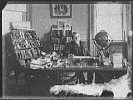
|

CSE 312, Wi '17: Approximate Schedule |
|
 CSE Home CSE Home |
 About Us About Us |
 Search Search |
 Contact Info Contact Info |
Schedule details will evolve as we go; check back periodically to see the latest updates.
| Due | Lecture Topic | Reading | ||
|---|---|---|---|---|
| Week 1 1/2-1/6 |
W | Introduction | Berteskas Ch 1 | |
| F | Counting: combinations, permutations, etc. | |||
| Week 2 1/9-1/13 |
M | Probability: Axioms, Conditional Probability, Bayes, Independence, etc. | ||
| W | HW #1 | |||
| F (notes) | ||||
| Week 3 1/16-1/20 |
M | Holiday | ||
| W | HW #2 | Probability: Axioms, Conditional Probability, Bayes, Independence, etc. | ||
| F (notes) | ||||
| Week 4 1/23-1/27 |
M (notes) | |||
| W (notes) | HW #3 | Discrete Random Variables, PMFs, Expectation, Variance, Joint Distributions | Bertsekas Ch 2 | |
| F (notes) | ||||
| Week 5 1/30-2/3 |
M (notes) | |||
| W (notes) | HW #4 | |||
| F (notes) | ||||
| Week 6 2/6-2/10 |
M | Snow Day | ||
| W (notes) | Midterm Review | |||
| F | ||||
| Week 7 2/13-2/17 |
M (notes) | Discrete Random Variables, PMFs, Expectation, Variance, Joint Distributions | ||
| W (notes) | HW #5 | |||
| F | Midterm | |||
| Week 8 2/20-2/24 |
M | Holiday | ||
| W (notes) | HW #6 | Continuous Random Variables, CDFs, PDFs, Normal Distribution | Bertsekas Ch 3 | |
| F (notes) | ||||
| Week 9 2/27-3/3 |
M (notes) | Max Likelihood Estimators, EM | Bertsekas, 9.1. Supplementary reading below. | |
| W (notes) | HW #7 | |||
| F (notes) | Tails and Limit Theorems | Bertsekas Sect 4.4 & Ch. 5 | ||
| Week 10 3/6-3/10 |
M (notes) | |||
| W (notes) | HW #8 | |||
| F | Wrap up & Review | |||
| Week 11 3/13-3/17 |
M | Final Exam |
||
Textbooks:
Required:
Introduction to Probability (2nd edition), Dimitri P. Bertsekas and John N. Tsitsiklis, Athena Scientific, 2008(Available from U Book Store, Amazon, etc.)
Reference. (No direct use of this, but if you already own a copy, keep it for reference. Some students have said they like its coverage of counting (Chapter 5 and 7.5, 7.6) and discrete probability (Chapter 6). Editions other than the sixth are probably equally useful.):
Discrete Mathematics and Its Applications, (sixth edition) by Kenneth Rosen, McGraw-Hill, 2006. Errata. (Available from U Book Store, Amazon, etc.)
Supplementary Reading:
In addition to the assigned text, there are many supplementary resources available on the web and elsewhere that may be helpful. Here are a few. I welcome hearing about others that you discover.
The open access textbook for the Chance project. Roughly comparable in coverage to Ross or Bertsekas, but with a different slant, of course.
|
Computer Science & Engineering University of Washington Box 352350 Seattle, WA 98195-2350 (206) 543-1695 voice, (206) 543-2969 FAX | |